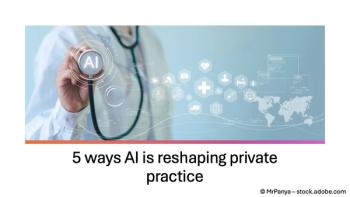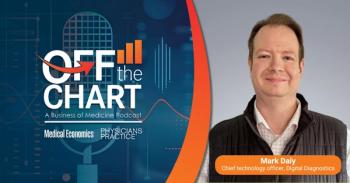
The Tech Doctor: Hands-Free Typing
Has voice recognition technology finally advanced enough to be reliable?
It’s the Holy Grail of high-tech medicine: Simply speak into your computer, and it types your every word.
Well, the Grail may be closer than you think.
The development of voice recognition software has made such huge strides during the past few years that many physicians now consider it a must-have tool. New software incorporates sophisticated medical vocabularies, and some accuracy rates exceed 95 percent.
What’s more, a number of software products support continuous speech, so you can talk at your normal cadence and tempo (up to about 160 words per minute). For those of you who’ve made or are making the transition to electronic medical records, many EMR vendors are integrating voice recognition software into their product suites, making it ready for use as soon as you begin entering chart data.
Compared to traditional dictation services (which can easily exceed $1,000/month per physician), voice recognition software offers a nice financial return while also eliminating turnaround times spent waiting for the delivery of completed transcripts.
So how does it work? Using the software requires either a headset or handheld microphone plugged into a PC. Physicians must first establish a “voice profile” to ensure the greatest possible accuracy, which entails “training” the software to recognize individual voices. This training takes just a few minutes to get started, but the software continues to “learn” an individual’s voice over time - which means it becomes more accurate the more you use it.
Using voice recognition software is a bit like having a transcriptionist in a box, but with the added bonus of immediate results. As you speak, your words appear on your computer screen. If you detect an error, you can use voice commands, such as “erase” or “correct” to make a fix. Therefore, the full burden of correcting errors falls on you rather than on a transcriptionist.
If you purchase an EMR that offers voice recognition as part of an integrated package, the program will also understand software commands specific to that EMR, such as “open chart” or “start progress note.” But unless you are completely typing-averse or physically limited from using a keyboard or other data-entry device such as a stylus, using voice commands as a means of navigating such software remains much slower than simply performing these tasks via traditional data-entry methods.
Since most EMRs offer a host of progress note creation tools (such as templates that allow a fairly rapid point-and-click means of documenting), many doctors find voice recognition capabilities in this area unnecessary. However, for the subjective portions of patient encounters that are difficult to fit into prefab templates or that may require additional nuance, voice recognition software embedded within an EMR may prove quite useful.
Product variables
Ironically, while voice recognition is a sophisticated and useful technology, its true strength lies in its ability to create unstructured data. This is slightly old-school in our era of pay-for-performance and population and disease management, in which physicians are evaluated based on objectively measurable and reportable (i.e., structured) data.
Like all IT tools, there are technical problems specific to voice recognition software. Although it’s offered as a network application (meaning that it can be installed on a server and delivered over a network to individual workstations), it’s more commonly installed on individual PCs. So when you purchase this software for your specific PC, you’ll want to ensure your machine matches the specs of the product you want to buy.
For example, when I was recently shopping for such software, the requirements for a well-known brand included a Pentium 4/1 GHz processor, a 16-bit sound card, and 512 MG of RAM (although more RAM is always better). The bottom line for me: My desired software package was not compatible with my recently purchased laptop (wrong processor), and my year-old desktop would require additional RAM and a sound card to run the product.
Also keep in mind that voice recognition products require a microphone as well as software to operate. Microphone selection is important. The best bet is to select a microphone with a USB connection and one that has been certified by the company that produces the voice recognition software you are purchasing. And regardless of the quality and compatibility of your microphone, remember that the distance between your mouth and the device can greatly impact the accuracy of your voice recognition, as can ambient noise. So you may want to lower the volume on your office muzak.
Shop smart
With the above tips in mind, should you head to your local office supply store and buy an off-the-shelf brand?
Probably not. You’re better off investing in a system with a built-in medical vocabulary. One of the most experienced suppliers is Dragon Naturally Speaking Medical Solutions, which offers a 250,000-word medical vocabulary (including specific vocabularies for different specialties). You’ll pay more for a medical version, but it’s well worth the investment.
If your plan is to integrate voice recognition software with your existing EMR, you’ll want to make your purchase directly from your EMR vendor to ensure compatibility. EMR vendors design their products’ voice integration features around a specific supplier and a specific version.
While the ability to automatically transform your speech into typed text is impressive, it’s not for everyone. Training your software to recognize your specific voice and intonation takes time, and to ensure accuracy, you must be able to control your environment while dictating in terms of microphone placement and ambient noise. That may not be possible in a busy practice in which you are frequently interrupted between visits. And no program is flawless; you will always have to go back and correct errors.
But for some physicians - particularly those who aren’t the world’s greatest typists - it can be a terrific timesaver.
Bruce Kleaveland is president of Kleaveland Consulting, a management consulting firm focused on healthcare IT. Prior to forming Kleaveland Consulting, he was chief operating officer at a leading EMR company. He can be reached at 206 527 6633,
This article originally appeared in the September 2007 issue of Physicians Practice.
Newsletter
Optimize your practice with the Physicians Practice newsletter, offering management pearls, leadership tips, and business strategies tailored for practice administrators and physicians of any specialty.














